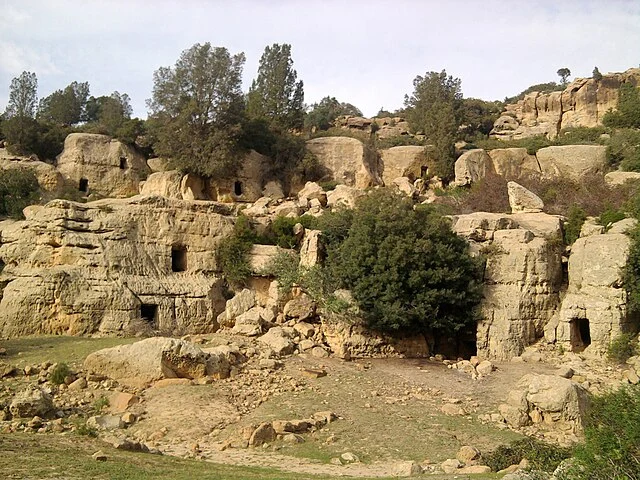The Haouanet of Sidi Latreche are ancient rock-cut tombs located in the region of Aïn Defla, Algeria. These tombs represent a significant archaeological and historical site, providing insight into the burial practices and cultural life of ancient North Africa.
Get your dose of History via Email
Description and Structure
The Haouanet are simple, rectangular rock-cut tombs. Each tomb typically consists of a single chamber, carved directly into the limestone cliffs. The tomb entrances are small and rectangular, often leading to a modest interior space intended to house the deceased. Unlike more elaborate tombs found elsewhere, these chambers lack decorative elements or complex architectural features. However, their simplicity offers valuable information about the people who created them.
Historical Context
Archaeologists date the Haouanet of Sidi Latreche to the late 1st millennium BC and early 1st millennium AD. This period coincides with the presence of the Numidian civilization, which occupied much of North Africa during that time. The Numidians were a Berber-speaking people known for their distinct culture and interactions with both Carthaginian and Roman civilizations.
The Haouanet likely served as burial sites for local inhabitants, reflecting the practices and beliefs of the Numidian society. While the exact purpose of these tombs remains debated, they likely housed the remains of common people rather than elites, who might have been buried in more elaborate structures.
Archaeological Significance
The Haouanet of Sidi Latreche contribute to our understanding of the ancient North African burial practices. These tombs represent a specific funerary tradition that contrasts with the more elaborate tombs found in other parts of the Mediterranean world. Their simplicity suggests a focus on practicality over ritualistic grandeur, indicating a society where burial customs were perhaps more egalitarian.
Moreover, the Haouanet provide evidence of the continuity of cultural practices in the region. The tombs show similarities to other North African burial sites, indicating a shared cultural heritage among different Berber groups. This continuity helps archaeologists trace the development of Berber societies and their interactions with neighboring civilizations.
Preservation and Challenges
The preservation of the Haouanet of Sidi Latreche faces several challenges. Natural erosion, human activity, and environmental factors threaten the integrity of these ancient tombs. Over time, many of the tombs have suffered damage, making it difficult for archaeologists to conduct detailed studies. Additionally, the lack of formal protection and conservation efforts puts these important historical sites at risk of further degradation.
Efforts to preserve the Haouanet are crucial for maintaining the historical and cultural heritage of the region. Increased awareness and recognition of their significance can contribute to the development of preservation strategies, ensuring that these ancient tombs remain a valuable resource for future generations.
Conclusion
The Haouanet of Sidi Latreche are a vital link to the ancient past of North Africa. They offer insights into the burial practices, cultural traditions, and societal structures of the Numidian civilization. While simple in design, these tombs are rich in historical significance. Preservation efforts are essential to protect these archaeological treasures, ensuring they continue to provide valuable knowledge about the ancient world.
Source:

